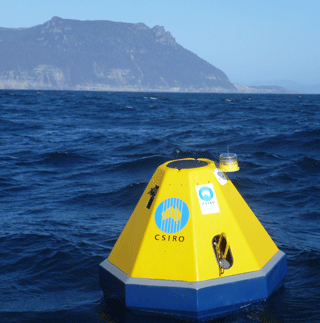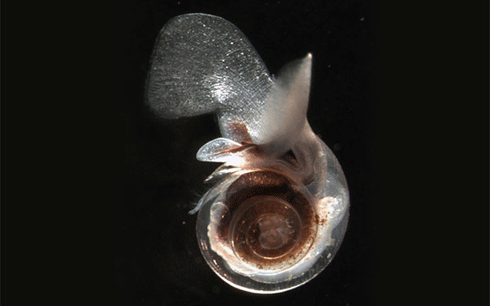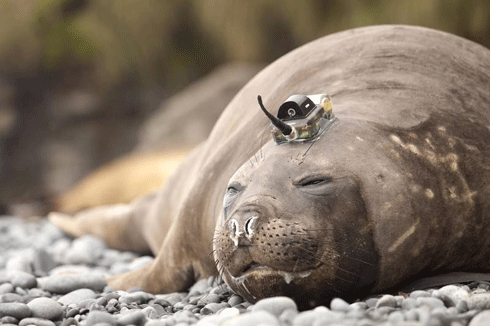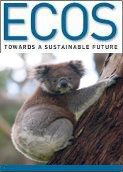
|
Published: 22 April 2013
Extra acid test for Australia’s oceans
CSIRO has just announced the deployment of a $150,000 mooring off Tasmania’s Maria Island, to further Australia’s research on climate change. The mooring is equipped to measure the chemistry of the Tasman Sea, specifically its acidity. So, then, what has seawater chemistry to do with climate change?

|
|
The new CSIRO mooring with Maria Island in the background. Credit:
CSIRO
|
Over the past 200 years, as humankind has ramped up the planet’s greenhouse gas emissions, the oceans have been absorbing about 25 per cent of the extra carbon dioxide.
While this has benefited the planet, the oceans have paid a price, as the additional carbon dioxide reacts with seawater to increase acidity levels and reduce the concentration of dissolved carbonate ions. This reduces the bio-availability of carbonate used by corals and shellfish to form shells and other ‘exoskeletons’ of calcium carbonate.
According to Dr Bronte Tilbrook from CSIRO’s Wealth from Oceans Flagship, elevated levels of carbon dioxide in the atmosphere have made the oceans about 30 per cent more acidic in the past 250 years. He says that while the potential impacts of acidification will be felt from the Great Barrier Reef to the Southern Ocean, scientists currently know little about the resilience of these diverse ecosystems to such change.
‘Predicted impacts range from a decline in the growth of shells and skeletons of important species, including corals and some shellfish, to shifts in the structure and dynamics of ecosystems,’ said Dr Tilbrook.
‘The Australasian region contains some of the world’s most extensive carbonate-based marine ecosystems, ranging from the coral reefs of the Great Barrier Reef and Indo-Pacific, to the earth’s largest cool-water carbonate platform along the southern Australian shelf.’
Further south, in the surface waters of the Southern Ocean, some of the most profound shifts in carbonate chemistry will occur by mid-century, say scientists, potentially influencing the survival of deep-sea coral communities and calcifying pelagic species, such as the delicate pteropods – tiny swimming sea-snails that are an important link in the marine food chain.

|
|
A tiny pteropod: a group of animals vulnerable to ocean acidification. Credit:
NOAA
|
The Maria Island mooring is the latest addition to the global International Marine Observing System (IMOS) – a network of marine observation facilities operated by ten different institutions across Australia. Through IMOS, equipment is deployed at key locations to deliver data streams for use by the entire Australian marine and climate science community and its international collaborators.
While the Maria Island mooring will keep an eye on the Tasman, another on the central Great Barrier Reef near Townsville is helping measure changes in the waters of the Great Barrier Reef.
Another mooring to the west of Kangaroo Island, South Australia, is monitoring changes off the southern Australian shelf. These deeper waters can seasonally upwell onto the South Australian continental shelf; these upwelled waters tend to have higher carbon dioxide concentrations, potentially exposing this ecosystem to acidification earlier than other regions.
Sensors on the Maria Island mooring also measure temperature, salinity, oxygen, chlorophyll and turbidity, while water samples are taken each month for plankton and nutrients. Basic measurement samples have been collected at Maria Island by CSIRO technicians monthly since 1944, providing scientists with an enviable ocean monitoring record.
The instruments are managed and operated by CSIRO and the data is available free to the public at http://www.csiro.au/tasman/nrsweb/ or http://imos.aodn.org.au/webportal/
Apart from deep-water moorings, the IMOS network includes ocean-going robotic floats, ships and research vessels, a remote-controlled underwater vehicle, and ‘wired’ seals and fish.
Indeed, tagged elephant seals recently proved their worth by enabling a group of Antarctic researchers to take measurements in the sea off a part of the Antarctic coastline that is inaccessible to ships. Thanks to the seals, the researchers discovered a fourth source of the deep-ocean streams of cold water – known as Antarctic Bottom Water – that help to regulate the Earth's climate.

|
|
An elephant seal equipped with sensor. Credit:
Chris Oosthuizen/IMOS
|
A podcast and vodcast featuring Dr Tilbrook can be accessed here



